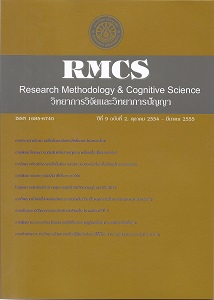การประมาณช่วงความเชื่อมั่นของสัมประสิทธิ์การแปรผันแบบใหม่ สําหรับตรวจสอบการกระจายของผลผลิตทางการเกษตร
Main Article Content
Abstract
การวิจัยนี้มีวัตถุประสงค์เพื่อพัฒนาวิธีการประมาณช่วงความเชื่อมั่นของสัมประสิทธิ์การแปรผันแบบใหม่ และตรวจสอบ ประสิทธิภาพของวิธีการประมาณแบบใหม่ที่พัฒนาขึ้นกับวิธีการประมาณแบบเดิม ได้แก่ วิธีของ Miller วิธีของ Vangel และ วิธีของ Mahmoudvand & Hassani จากนั้นนําวิธีประมาณแบบใหม่ไปใช้ในการตรวจสอบความแปรผันของผลผลิตทางการเกษตร ได้แก่ มันสําปะหลัง ยางพารา ข้าวโพด และ ข่าว ข้อมูลที่ใช้ในการวิเคราะห์คือค่าเฉลี่ยผลผลิตระหว่าง ปีพ.ศ. 2549 – 2553
ผลการวิจัยแสดงให้เห็นว่า วิธีการประมาณช่วงความเชื่อมั่นของสัมประสิทธิ์การแปรผันแบบใหม่หีผลดีกว่าวิธีการประมาณ แบบเดิม เมื่อกลุ่มตัวอย่างมีขนาดมากกว่า 30 และประชากรสัมประสิทธิ์การแปรผันมีค่ามากกว่า 0.5 ส่วนการตรวจสอบการแปรผันของ ผลผลิตทางการเกษตร ปรากฏผลว่า มันสําปะหลังมีผลผลิตคงเส้นคงวาในสภาพแวดล้อมต่างๆ ดีกว่า ข้าวโพด ยางพารา และข้าว
The New Method of Approximation for Confi dence Intervals of Coeffi cient of Variation Used for Studying Agricultural Products Variation
Vorrapot Saelee1, Suchada Kornpetpanee2 and Patcharee Wongkasemb2
1Yala Rajabhat University, Thailand
2Centre for Advanced Statistical Analysis College of Research Methodology and Cognitive Science, Burapha University, Thailand
The purposes of this study were to develop a new method to approximate the confi dence interval of coeffi cient of variation, and to compare the effi ciency with other methods: Miller’s, Vangel’s, and two types of Mahmoudvand & Hassani’s methods. The Monte Carlo technique was employed in the simulation. The new approximation method then was used to examine the variation of agricultural products: cassava, rubber, maize, and main rice. Data in the analysis were the average products in the years 2006-2010.
The result showed that the new approximation method was better than other methods when the sample size was more than 30 and the population of coeffi cient of variation was more than 0.5. The examination of the variation of agricultural production found that cassava was more stable across environments than maize, rubber, and main rice.

